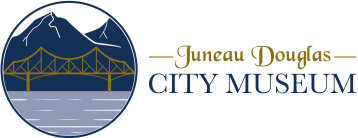Gastineau Channel Memories
Kendall, Richard & Alice (Van Gundy)
Alice (Van Gundy) Kendall
My parents and grandparents were western Nebraska \"Sand Hill\" homesteaders under the Kincaid Act of 1904. These early settlers built homes of sod blocks, as trees and money were nonexistent. The tworoom soddies were heated by a cast iron cookstove fueled by buffalo chips. I was born July 15, 1911.
The children were home schooled through the elementary grades. After graduation from Fremont, Nebraska High School and a year of decision making I entered the Cook County School of Nursing in Chicago and later the University of Chicago.
World War II was raising its ugly head, claiming the male members of the family. My husband, Richard, was stationed in Ketchikan aboard a U.S. Coast Guard Ship. Families of military personnel were required to have employment benefiting the war effort and written permission from the Commandant of the 17th Naval District to enter the Territory. Commandant J. Simpson McKinon was in the Aleutians during the Japanese attack. Two years and reams of paperwork later, I received the official permission. On a stormy November 1944, day the plane loaded with military supplies and three passengers sat down in a cow pasture ?out the road.? The dairy cows ran for the barn and we were directed to the airport, a metal quonset hut. Juneau streets were wall to wall with service men. No visible lights, blackout at sundown. Official identification was required to step on the marine docks. Alaska Juneau Mine was closing. At the end of the day the miners trudged down Mt. Roberts single file. The carbide lamps on their helmets lit the way. The permanent population of Juneau was 5000.
We found an apartment above Erwin?s Grocery located on Franklin Street, what is now Little Switzerland Jewelery. The Coliseum Theater was two doors north and burned in that cold winter of 1945. The pipe organ was saved and is now in the lobby of the State Office Building. In this period, the organist supplied the background music for the silent movies.
Respectable women were advised not to walk unescorted south of where the Library and Parking Garage are now located. South Franklin was known as the red light district. The dairy farmers winter pastured the herds where the high school is now. It was the ?outskirts? of Juneau. The Gastineau School property was a winter pasture in Douglas. Not only did the telephone operators serve as the local ?information bureau? they notified the longshoremen of the ship arrivals. No buttons to push-we just lifted the receiver and heard the friendly voice asking, ?Number, please??
Dr. Leonard Dawes and Dr. Joseph O. Rude were the appointed military medics. Fortunately, for me, they needed an R.N. Their clinic was on Front and Franklin, second floor. Two blocks south on Franklin Dr. C.C. Carter and Dr. William Whitehead operated a large clinic. These dedicated general practitioners kept St. Ann?s Hospital on Sixth Street a beehive of activity. The ?Native Village? on Willoughby Avenue maintained a hospital and school under the supervision of the Bureau of Indian Affairs.
In spring, 1946, the Fish Processing Unions ruled that medical aid was mandatory at all locations. A meeting of the medical minds decided I was to establish the first privately owned and operated First Aid Station in the Territory. Pelican, Alaska did not have the required percentage of Native people for the BIA or Public Health to participate. Annual permanent population was 100, seasonal workmen and fishing families increased the number to 1000 during the summer months. Off to Pelican with $9.00 worth of supplies and essential donated instruments. Our residence and First Aid Station was a miner?s cabin, and later a fish scow anchored to the boardwalk. There were no telephones, (medivac and television were only words in the dictionary) but we had a World War II surplus radio at the Cold Storage, which never worked when needed. The R.N. duties were varied and complex. Every situation was a challenge, from birth to death and social and medical problems in between. Serious medical and surgical patients were transported to Juneau by Pilot Prosper Ganty, in his Aeronca Chief. Many of those trips were in inclement weather, not fit for man or beast. The Juneau M.D.?s and pharmacists were my security blanket. When landing at the Alaska Coastal Airlines float, one of them would be waiting, ready to help.
After ten years in Pelican, we returned to Douglas and school for our son Vance. Once again, I joined the Doctors Clinic and retired in 1977. Since retirement I have been involved in volunteer work.
RICHARD C. KENDALL
?Dick? Kendall was born on the home farm in Northeast Pennsylvania. The vineyard and farm had been in the Kendall family since the early 1800?s.
He graduated from high school in Erie, Pennsylvania. Lake Erie was his backyard and he dreamed boats. Off to California where he joined the U.S. Coast Guard. He married Alice Van Gundy in 1942. His first tour of duty was Ketchikan, Alaska, aboard the Prince of Wales. The ship burned near Rocky Island claiming the life of one crewman. The Westfall brothers who were logging in the area plucked the crew out of the water and took them to Ketchikan. The next assignment was the Minana 2. This ship, plus routine duty, was assigned to Governor Gruening for transportation to Southeast towns for business meetings. Dick had papers in the mill for admission to the Coast Guard Academy. The war ended and he chose to take discharge in Ketchikan. One year later he was fishing his 32-foot troller.
Pelican years were busy and full serving on the City Council and Fishery Boards. Dick was happy fishing the southeast waterways and hunting the mountains that he knew so well. He reached his dream when he had the 54-foot fiberglass Sundowner built.
On return to Douglas he designed and built the present home on Second Street.
Richard expired May 1982.
